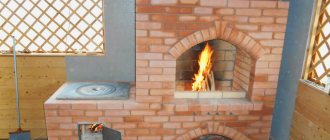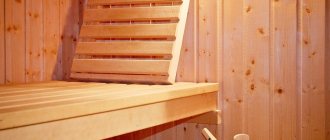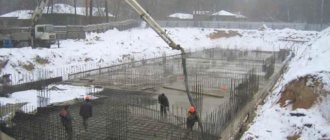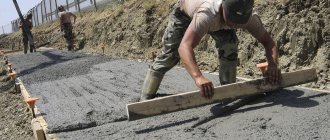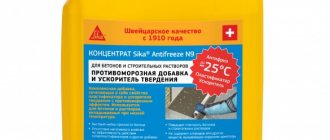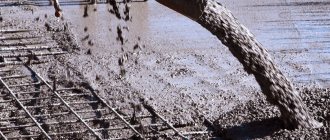In this article we will discuss the pressing question of whether it is possible to pour concrete in cold weather and how to do this with the least damage to the quality of the final result. It is no secret that the use of cement-containing mortars in winter is practiced in industrial construction, since the construction of individual low-rise buildings can be mothballed until the onset of the warm season.
However, there are exceptions to this rule, and concrete has to be poured into the formwork at sub-zero temperatures. Let's consider how this can turn out and how to avoid such consequences.
In the photo - laying the foundation at sub-zero temperatures
Is it possible to concrete in cold weather?
First, let’s figure out whether it’s possible to concrete in cold weather. With low temperatures already falling below zero, you shouldn’t stop your work, that’s for sure. Just use concrete mortar with special frost-resistant additives, which are sold at any hardware store. And the next step, be sure to wrap the fill with a covering material - the simplest one, which can be branches or construction debris.
How does cement mortar behave in cold weather?
Let's see how frost affects concrete. In the usual classic version of concrete mortar, as a rule, all the main components are mixed with water, which is the main problem. The water freezes and destroys the formative integrity of the solution. Here the strength and, accordingly, the reliability of such a mixture are reduced to zero.
Therefore, during the pre-winter and winter period of construction of buildings, it is imperative to mix special plasticizers into the cement composition, which can easily eliminate such problems.
Excavation
Frozen soil is not a gift: it is very difficult to work with for two reasons. Firstly, purely physically it requires a lot of effort. Secondly, loosened frozen soil is a mixture of lumps of rock hardness, between which air voids remain. It is not as flexible as in summer, so compacting it is not possible at all. When the soil thaws, it will inevitably sag, and very strongly. Therefore, in winter it is strictly not recommended to make embankments or backfill the foundation cavities along the walls.
But the “stony” hardness of the frozen earth can be used to your advantage. For example, some future homeowners take risks and dig trenches and pits in winter: since everything is frozen, the slopes can be neglected, and the vertical walls of the excavations cannot be secured. Thus, the volume of excavation work becomes less. Another thing is that the work itself may become more expensive, because workers will quite logically request an increased tariff.
Methods for developing frozen soil can be divided into several main types:
- mechanical loosening is done using tractor rippers or excavators;
- if you need to thaw the soil, use heating elements, hot houses, fires, electric heating and salt solutions;
- If you need to slow down the freezing of the soil as much as possible, you can soak it with a salt solution. This may be necessary if there is very little work left, and frost suddenly strikes. In this way, you can extend the process of “petrification” of the earth for several days.
But in general, experts say: excavation work in winter can be carried out only if it is absolutely necessary.
Photo ustanovkasvai.ru
Advantages and disadvantages
Winter construction has its pros and cons.
You should be very careful when buying concrete powder in winter, since during this period of the year the air humidity is quite high, the cement can get wet or become saturated with condensation - all this makes it unsuitable. Disadvantages include significantly reduced working hours due to shortened daylight hours.
The advantages include:
- lower prices for all goods for your construction;
- if the soil on which you are building is very unstable and loose, then frozen soil is the best option for this case;
- All access roads to your property remain solid and clear. As a rule, in other seasons, especially in spring and autumn, there is a lot of dirt there.
Pile work
Purely technically, it is possible to screw in piles in winter. But at the same time, we will encounter the problem described above - frozen soil. But you need to drill a well. Of course, there are technical methods that will alleviate this issue, but all this will be expensive and difficult.
If the temperature outside is above zero and the soil has not yet frozen, the piles can be screwed in. If it’s minus outside, you’ll have to drill the soil with a hammer drill, and this is extremely labor-intensive. Of course, experts find ways - they install heating elements in wells, burn acetylene at the site where the pile is driven (to heat the ground). But all this is such a complicated dance with a tambourine that it’s worth thinking ten times whether it’s worth it and whether it’s still possible to wait until the start of the traditional construction season.
How to pour concrete correctly in winter?
Let's look at the most acceptable options for winter pours, which do not violate the basic technical requirements and make concrete foundations of the same quality as in the summer.
Application of PMD
Frost-resistant additives, or antifreeze, are created specifically for cold weather. Such impurities help maintain normal temperature conditions, at which the water does not freeze and the cement composition sets well. There are different ones - they operate from minus five to minus twenty-five degrees Celsius. Depending on your weather conditions, buy the ones that suit you.
Electric heating
A very successful method of heating concrete in frosty conditions, it is very popular. In this case, they take electrodes and use them to supply electric current directly to the concrete solution, thanks to which it maintains the required temperature well.
What to cover with after pouring?
The most budget-friendly way to pour in cold weather is to insulate the concrete mixture. How to cover concrete after pouring in winter? Simple PVC film tape or other covering materials (any kind you purchase in the construction department) perfectly retain the thermal regime in the cement mortar.
Gas and electric heat guns
Many types of fan heaters, gas heaters, electric heaters (your choice) have unique abilities to maximize air temperature. Work with such installations is relevant even outdoors.
Another option for pouring concrete in winter is also possible, for example, heating the water that you pour into the solution. In this case, work is carried out quickly, without stopping. Inexpensive, but too troublesome.
Use of additives
These chemicals are divided into groups according to the way they affect the concrete mixture:
- Additives that prevent water from freezing at sub-zero temperatures and allow cement hydration to occur. They are best used in combination with heating to shorten the setting and hardening periods.
- Additives are accelerators that have antifreeze properties. Their function is to sharply increase the activity of cement and thus force the concrete to gain its design strength regardless of the ambient temperature. They are successfully used without heating the structures.
- Substances that accelerate the setting of the solution and cause maximum heat release, which is why the monolith initially heats up on its own.
Reference. From a financial point of view, the introduction of additives is considered the most profitable method, since electric or air heating of concrete is more expensive.
A feature of the use of any additives is compliance with the exact dosage in accordance with the concreting conditions, especially when combining substances. The fact is that some of the compositions initiate the appearance of rust in the reinforcement frame, but impart antifreeze properties to the water. Others are corrosion inhibitors, so both groups are used together.
Hence the conclusion: do not try to make a solution for winter construction yourself by adding additives; such material must be ordered from the factory and delivered by a concrete truck (in the jargon - a mixer). Contact the company’s specialists and find out at what temperature their products can be used to pour the foundation without consequences. In case of emergency, correctly combined and accurately dosed admixtures can reduce the threshold for laying the solution to minus 25 °C.
The following substances most often act as antifreeze and accelerating additives:
- potassium carbonate (potash);
- various calcium and sodium salts;
- urea (otherwise known as urea);
- sodium formate.
You will learn more details about chemical impurities - modifiers from the following video:
Possible consequences
In special frosty conditions, you must remember to follow all the rules for winter filling, otherwise irreversible consequences may occur, after which there can be no talk of any further operation of your facility. Therefore, you must strictly take into account all the standards and calculation data of this matter.
If you pour liquid into concrete during frost and do not do it correctly or with some, even minor, violations, then the thermal processes of hydration in the formwork, which proceed and are completed after about three to five days, may stop completely.
This leads to sad consequences; as a rule, the surface layer of your fill will be loose and crumbly. In this case, the work needs to be completely redone.
Interior decoration
If the house is already generally ready and heating is supplied to it, no questions arise at all: you can even tinker with the arrangement until spring. General requirements for finishing work are maintaining adequate temperatures and humidity in the room. The air temperature near the outer wall should not be lower than +15°C, the temperature of the surface to be finished should not be lower than +5°C. Glues, solutions and mastics must be kept at least at +15°C.
If there are frozen surface areas on the wall, they must be warmed up and dried before finishing. Do not allow drafts in the room under any circumstances.
But the outside of the house can be plastered only as long as the temperature remains above +5°C. You can’t do this in winter: all the work will go down the drain.
Lyudmila Gubaeva
Real Estate Tatarstan
What should you do if you have poured the foundation and are suddenly hit by frost?
We paid attention to how to pour, insulate and what to cover concrete after pouring in winter. However, it often happens that even in September night frosts can hit quite sharply and quite severely. What to do if something like this happened and you poured the foundation.
Ways to solve the situation:
- If you have added antifreeze to the concrete mixture, then you don’t have to worry, your work is not in danger.
- If you didn’t add it, then it’s best to insulate your fill for five days with a covering material so that all the necessary processes go through and the cement strengthens. After this, frosts are not terrible.
In general, winter construction is already considered weather conditions when the air temperature drops to plus five degrees. You can, of course, stop construction during this cold period of the year, but this can lead to losses such as time. Therefore, make your choice, build beautiful and reliable buildings and live with pleasure!
Laying gas blocks
As experienced builders say, this can also be done. But such work will be very expensive.
First, the blocks will need to be heated. For example, make a frame around the pallet, cover it with a warmer and put a heater inside (and this will be monstrously expensive in terms of electricity). One pallet of gas blocks heats up for about an hour. If the blocks are not heated, the water and glue will freeze immediately.
Secondly, you will need boiling water at the construction site: when laying the blocks, they are moistened with water to increase adhesion. If you water them with cold water in the cold, a crust of ice will simply form on the surface. But you can’t put it on ice.
Thirdly, you will need to stock up on a plastic container with thick walls and a lid so that the glue freezes more slowly. And, by the way, you will also need to dilute it with hot water (but not boiling water - it will “kill” the entire solution).
Of course, the glue must be winter-grade (with plasticizers), and the cement must contain special additives.
